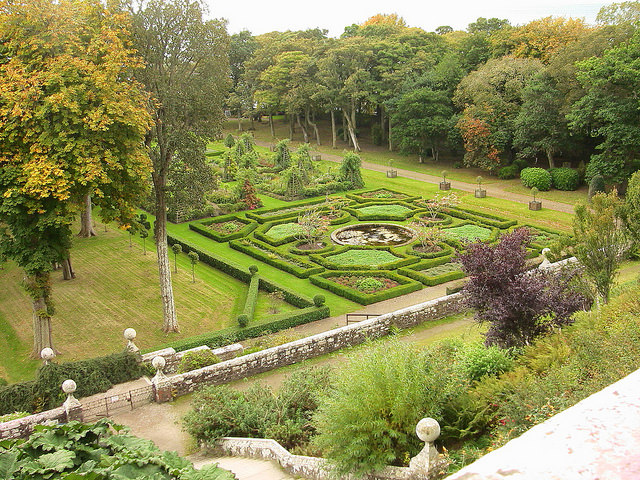
Landscaping Our Spiritual Lives
Some people use the analogy of a garden to describe spiritual life. They talk about how intentionally we tend our own gardens, planting and watering and weeding. I have read what people have written about whether we want to plant food or flowers.
There are people who prefer formal, structured gardens which follow intricate plans. Other people grow natural gardens with organic seeds and indigenous plants. Some of us include dramatic water features while others are growing drought-resistant gardens.
Each of us can choose and plan what sort of garden we want to grow. At the same time, we each depend on the same life to bring our choices and plans to reality.
What Kind of Garden Are We Growing?
Gardening and landscaping demand our physical effort and our mental attention. Our landscaping plans begin in our minds. We draw them into a picture, then they become a garden. The landscaping we have begins with the garden we want.
I know people whose ideal garden is a lush, green lawn. They do not need border plants or flowers, but prefer the look and fragrance of green grass. The feel of grass under their bare feet is their reward. Their focus is on mowing and edging, not on fancy designs. Some people describe their gardens as simple, but it takes hard work to grow good grass.
Even a small garden or a small lawn gives us many choices to make.
Planning our landscaping is more than stating our personal preferences. Where we place plants in relation to each other affects how well they will grow. It can be easy for us to get carried away and believe we can do anything we want.
Our landscaping plans for spiritual life need to be based in more than what we would like. Like plants in our garden, we need to understand how the various things we want to grow fit together. Spiritual life is about relationships. The relationships between aspects of our spiritual lives show us how they support each other.
Our plans depend on how well the individual plants will grow together.
In addition to how our plants relate to each other, our gardens depend on the condition of our land. The soil may be exhausted, overworked, and underfed. We could be trying to start growing a landscape for which we have not prepared a place.
Preparing Our Soil
When we know where we would like to grow our garden we need to prepare the ground. After we understand the drainage and access of the location, we help the soil be receptive.
How well plants will grow depends, in part, on how we have prepared our land. We can break up soil which is tightly compacted and which makes it harder for plants to grow. There are nutrients and fertilizers we can add to the soil to encourage what we plant. It may be helpful for us to add support to the landscape or remove existing obstacles.
We work with our plot of land to make it more welcoming for plants and help them grow.
Preparing the soil takes focused hard work which has no immediate benefit or reward. We may not see how preparing our soil is helpful until plants begin growing. It can seem like a waste of our time and effort.
Preparing the soil for spiritual life landscaping can feel the same way. We work to develop habits and practices to open ourselves to spiritual life. It takes our effort each day for us to become more welcoming toward spiritual life. We break up compacted parts of our lives, remove obstacles, and add nutrients.
Part of strengthening spiritual life in us is becoming more amenable to its growing in us. The preparation may feel like a waste of time or effort at the moment. We will know only when things begin to grow.
When we have planned our landscape, considered the plants, and prepared the soil, we begin to plant.
Planting and Waiting
We recognize the growth of our landscape is, ultimately, beyond our control. Despite all our work and good intentions, our garden depends on growth we cannot force to happen. Our efforts rely on natural processes, including rainfall and sunlight, to come to fruition.
The best we can do is to do our part and trust for the rest. In landscaping, as in spiritual life, it is the lessons we learn by trusting we will remember.
No matter how well we have planned and prepared, our landscape will not spring forth spontaneously. It depends on our work of planting and tending to become real.
Each step of landscaping has the potential to get our hands more dirty. Every action carries lessons for us to learn, ways for us to become better landscapers. We enter into the intimate connection between the earth and life.
Planting is another part of our opportunity to create a garden. From idea to plan to planting, our landscape becomes more real.
We plant and we wait. Even as we wait we continue to work around the edges of our landscape. We make adjustments and clear away weeds and other obstacles. Our garden, our landscape is growing even though we may not realize it. Under the ground our planning and preparation and planting is beginning to bear fruit.
The Landscaping We Choose
The landscaping we have may not reflect the garden we thought we chose. Whether it is our idea or our planning and preparation or our planting, something happened. We may have not removed all the obstacles we thought we had. The soil may not be in good condition, or our plants may not get on well together.
Fortunately there is still time to work on the soil or replant. We can still affect the landscape of our spiritual lives.
Questions
How are we landscaping our spiritual lives this week?
Where is spiritual life growing in us, even though we may not realize it, today?
[Image by Wendy]
Greg Richardson is a spiritual life mentor and leadership coach in Southern California. He is a recovering attorney and university professor, and a lay Oblate with New Camaldoli Hermitage near Big Sur, California. Greg’s website is StrategicMonk.com, and his email address is [email protected].












